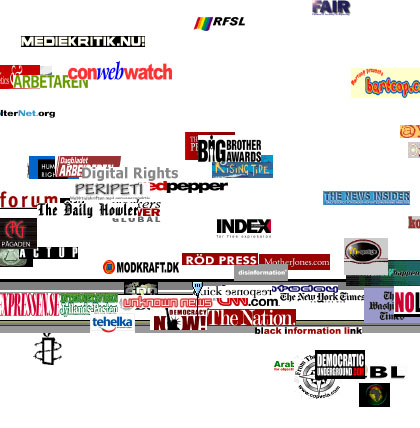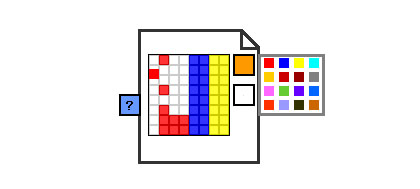 |
[June 1st 2004]

From Timeline [Who writes the history?].
Who writes the history?
- Interview with Petri Raappana
Swedish artist Petri Raappana (born 1966) - currently exhibiting his work Timeline [Who writes the history?] - sees his net artworks as part of contemporary art and has no problem with them being exhibited at a museum or a gallery. Kristine Ploug h has talked to him. Translated by Sofie Paisley.
Link to the artwork: http://www.artnode.org/art/raappana/timeline/index.php
First I would like to have the work Timeline explained - what does it do? What is the meaning of the swarms that appear on the screen, and how does one add a link?
Timeline [Who writes the history?] is a work that takes as its point of departure the mainstream media and the alternative news media. It is built with a line structure containing the logos of mainstream news media. These can be moved horizontally, forward and backwards.
By elongating the 'timeline' the 'swarm' is visualised with logos for alternative news media. The function of the swarm is to enable the user to click into these alternative news media. Next to the logos is a circular object. By clicking the object the user encounters something resembling an 'icon maker'. The user can create their own logo by colouring a template. After the colouring a question mark appears, and by clicking this a new browser is opened with the question 'Who writes the history?'. The user can then add an url, category and description to a link collection with alternative news media. The symbolic meaning of the swarm and of elongating the timeline can be seen as the user opening up a room with greater flexibility than the linear structure. Through the work allowing the user to add new links to the link collection the swarm expands and gives information about sites and places, so that the user gets access to more detailed news coverage.

Icon designer from Timeline [Who writes the history?].
It seems as though you have a political agenda, or at least want the art to be an alternative to the established communicators? What is the idea behind the work?
Art can function as an alternative to the mainstream media that are usually controlled by financial and political interests. The political aspect of the work is obvious as the work is indeed about media, which is the organ we are in daily contact with. The mass media play a big role in how our society looks, and in how we are as individuals in society. Timeline [who writes the history?] has been created on the basis of research on how the mainstream media are controlled today. The work has two links about the direction the mass media are developing.
http://www.corporations.org/media
http://www.etc.se/arkivet/textarkiv/Dans_artiklar/dj_000210_mediejattarna.html
The work will communicate alternative news sites and sites that one may not know contain communication of news. One of the goals of this work is also to inform about the structures behind the mass media.
How does the work then enter a context where it actually becomes an alternative to the media?
Timeline [Who writes the history?] will expand the space for news coverage by informing about the existence of alternative news sites. Mainstream media often overshadow important questions and events by using sensationalist and populist strategies. The links contained in the artwork are to sites that constantly treat, report and inform about important questions and events that could easily be overshadowed by mainstream strategies. Some of the links are to alternative news sites reporting news with other angles than the ones used by mainstream. Other links are to sites critical of the media, where people can comment or discuss the things the mass media are writing about. There are also links to associations and media that communicate news and deal with questions relevant for minorities. And as mentioned earlier, the user can add links to the work under the question 'who writes the history?'.

Add your own links. From Timeline [Who writes the history?].
In what way do you designate your art - should a work like Timeline [Who writes the history?] be specifically viewed specifically as netart, or rather as a part of contemporary art?
I see Timeline [Who writes the history?] as a part of contemporary art.
Whereas Alphabyte was dependent on the computer but not the Internet, Timeline [Who writes the history?] is an actual net artwork - as it is dependent on continually gathering information on the net and does not work off line. Alphabyte has been exhibited physically - most recently at the RADAR festival here in Copenhagen. What about Timeline, is it going to be exhibited on the net or can it be shown physically at a museum or gallery?
Timeline is dependent on the Internet to be shown as a whole, so you can say that the work is a net artwork. Of course a work like Timeline [who writes the history?] can be shown at a gallery or a museum as long as there is access to the Internet. But, to return to your previous question about the work being an Internet artwork or a part of contemporary art, then I don't think that art limits itself to media or rooms. The designation contemporary art is in the content of the work and reflects or comments on the social reality that human beings live in. The Internet has a big influence on how our communication is and functions, both in private and in public. The Internet is no longer such a new media to us, so that you can no longer separate the medium from our contemporary period and culture.
How is your work process with the digital medium? Do you make everything yourself?
I make most of it myself. Once in a while I get help on the technical solutions or collaborate with people, a musician for example made the audio side of Alphabyte.
Petri Raappana was educated at the Royal Danish Academy of Fine Art (1991-1998) and HBFK, Hamburg , (1994-1995).
More.
Interview with Petri Raappana from August 2001 about the work Alphabyte, which has also just been exhibited as a part of the RADAR-festival in Copenhagen: http://www.kopenhagen.dk/netkunst/articles/petriiint.htm
[Danish version: http://www.kopenhagen.dk/netkunst/articles/petrii.htm]
|
 |
|